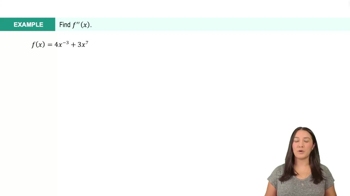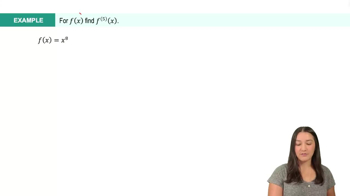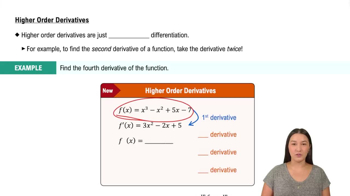Table of contents
- 0. Functions7h 52m
- Introduction to Functions16m
- Piecewise Functions10m
- Properties of Functions9m
- Common Functions1h 8m
- Transformations5m
- Combining Functions27m
- Exponent rules32m
- Exponential Functions28m
- Logarithmic Functions24m
- Properties of Logarithms34m
- Exponential & Logarithmic Equations35m
- Introduction to Trigonometric Functions38m
- Graphs of Trigonometric Functions44m
- Trigonometric Identities47m
- Inverse Trigonometric Functions48m
- 1. Limits and Continuity2h 2m
- 2. Intro to Derivatives1h 33m
- 3. Techniques of Differentiation3h 18m
- 4. Applications of Derivatives2h 38m
- 5. Graphical Applications of Derivatives6h 2m
- 6. Derivatives of Inverse, Exponential, & Logarithmic Functions2h 37m
- 7. Antiderivatives & Indefinite Integrals1h 26m
3. Techniques of Differentiation
Higher Order Derivatives
Problem 3.15
Textbook Question
If f(t)=t¹⁰, find f′(t), f′′(t), and f′′′(t).
 Verified step by step guidance
Verified step by step guidance1
Step 1: To find the first derivative, f'(t), apply the power rule of differentiation. The power rule states that if f(t) = t^n, then f'(t) = n * t^(n-1). For f(t) = t^10, n = 10.
Step 2: Calculate f'(t) using the power rule: f'(t) = 10 * t^(10-1) = 10 * t^9.
Step 3: To find the second derivative, f''(t), differentiate f'(t) = 10 * t^9 again using the power rule. Here, n = 9.
Step 4: Calculate f''(t) using the power rule: f''(t) = 9 * 10 * t^(9-1) = 90 * t^8.
Step 5: To find the third derivative, f'''(t), differentiate f''(t) = 90 * t^8 once more using the power rule. Here, n = 8.
Recommended similar problem, with video answer:
 Verified Solution
Verified SolutionThis video solution was recommended by our tutors as helpful for the problem above
Video duration:
3mPlay a video:
Was this helpful?

 2:42m
2:42mWatch next
Master Higher Order Derivatives with a bite sized video explanation from Callie
Start learningRelated Videos
Related Practice




